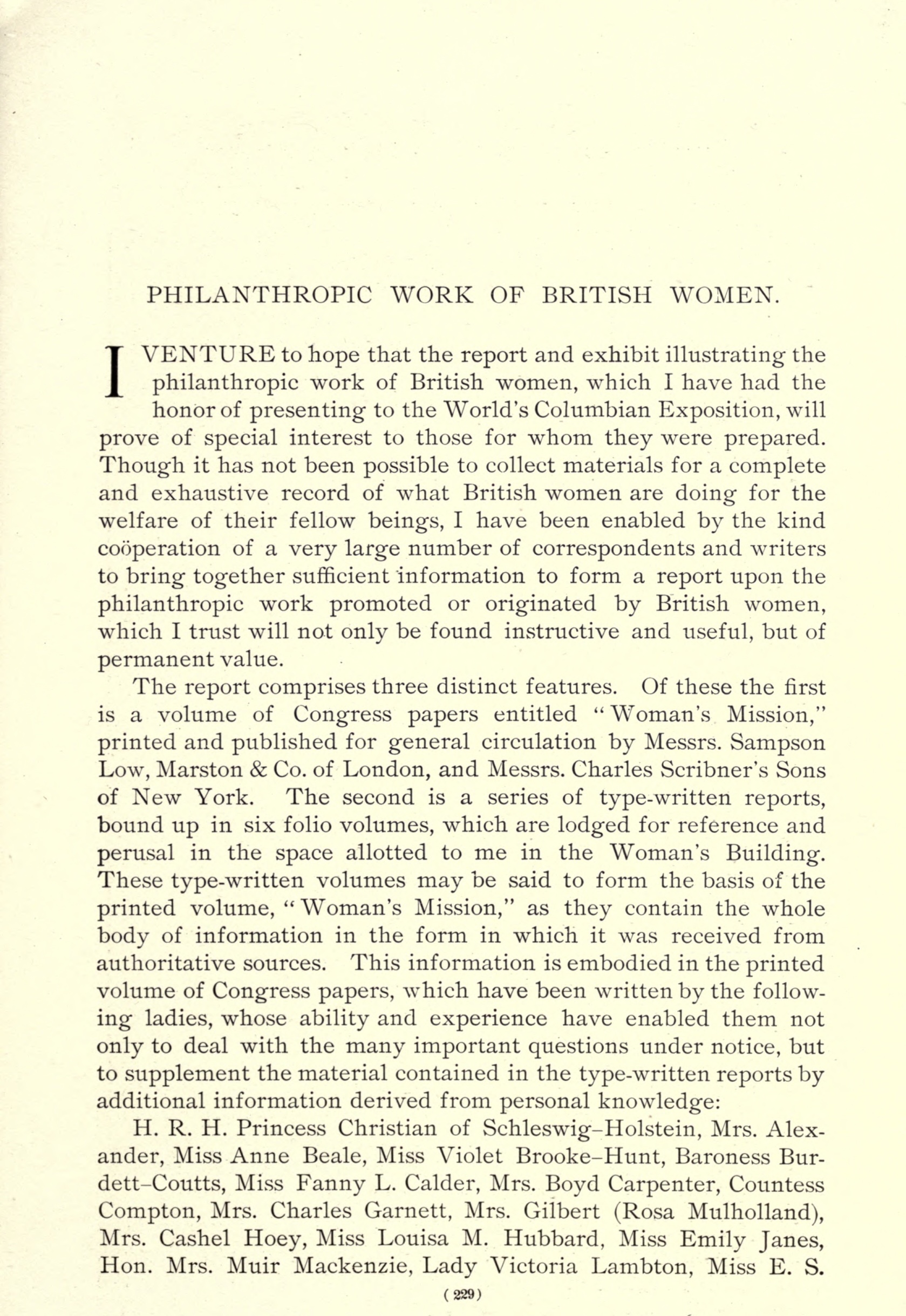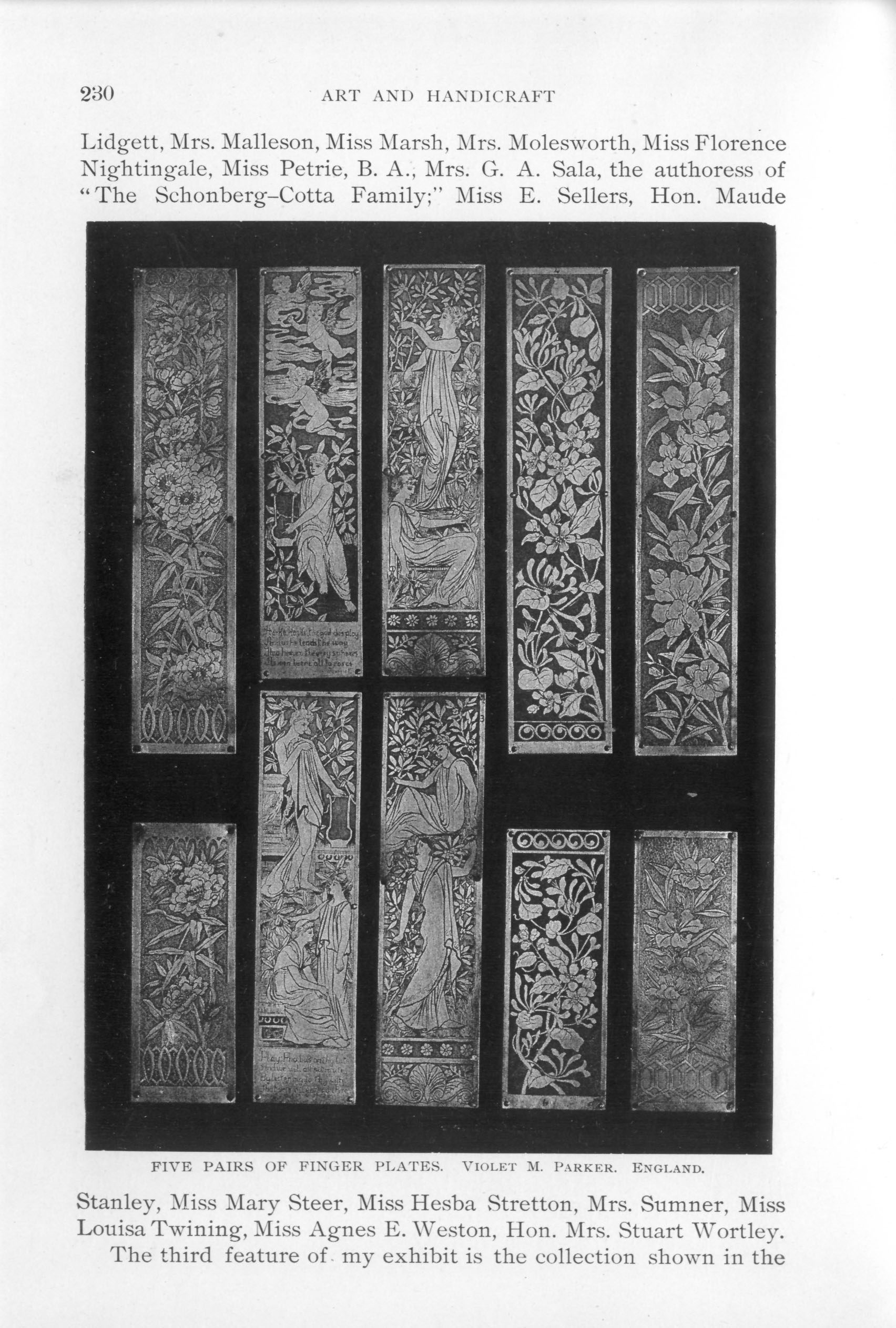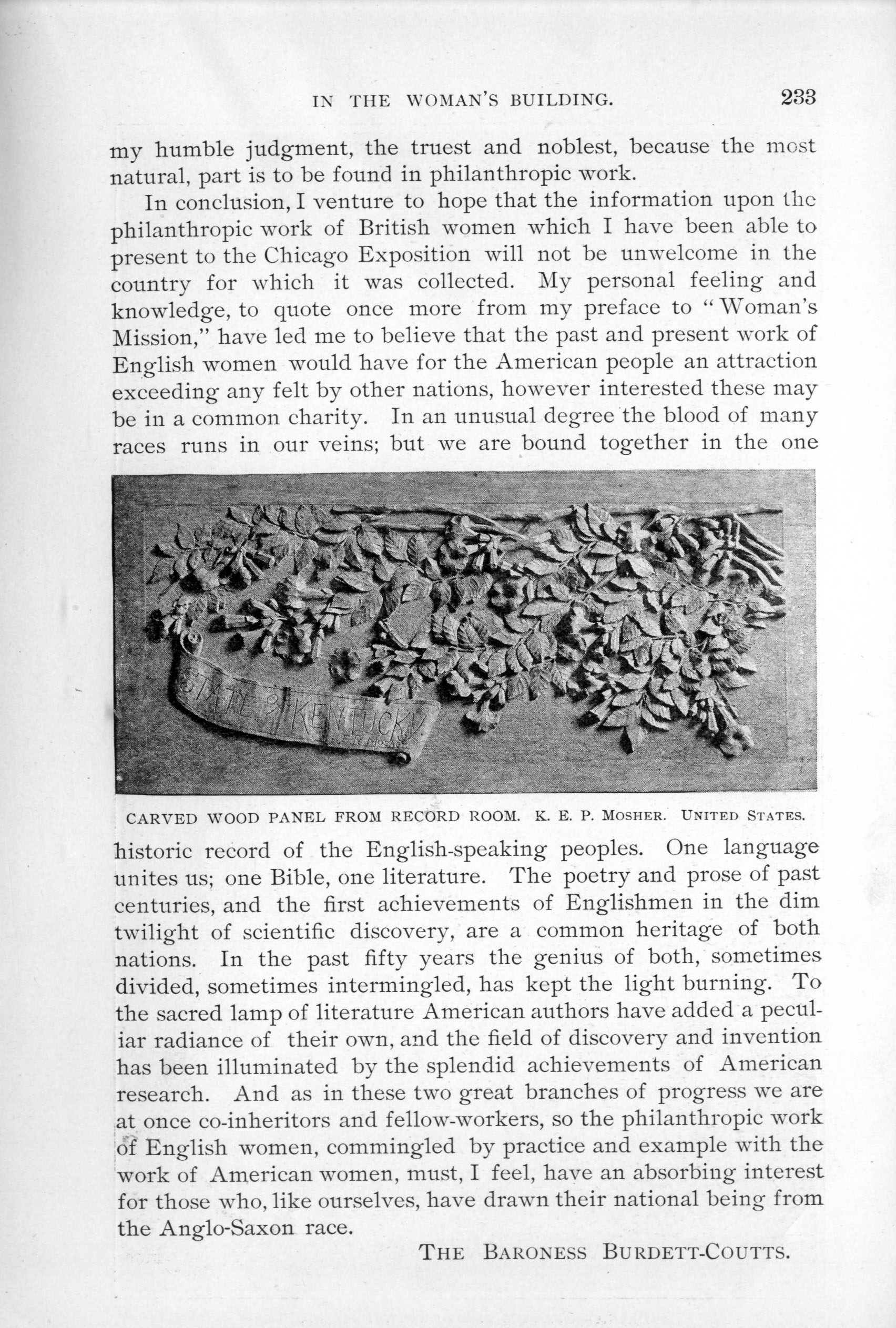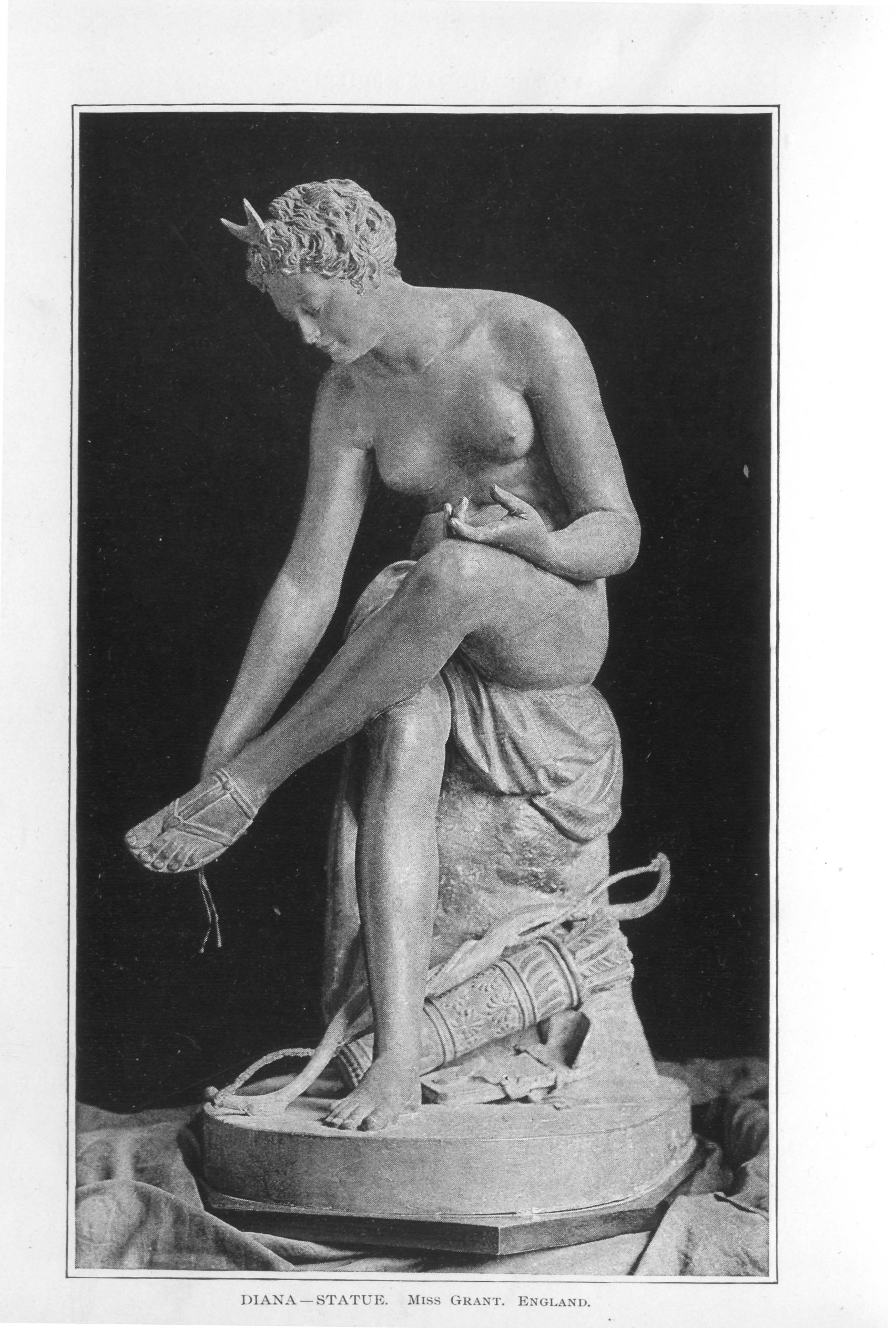
PHILANTHROPIC WORK OF BRITISH WOMEN.
I VENTURE to hope that the report and exhibit illustrating the philanthropic work of British women, which I have had the honor of presenting to the World's Columbian Exposition, will prove of special interest to those for whom they were prepared. Though it has not been possible to collect materials for a complete and exhaustive record of what British women are doing for the welfare of their fellow beings, I have been enabled by the kind coöperation of a very large number of correspondents and writers to bring together sufficient information to form a report upon the philanthropic work promoted or originated by British women, which I trust will not only be found instructive and useful, but of permanent value.
The report comprises three distinct features. Of these the first is a volume of Congress papers entitled "Woman's Mission," printed and published for general circulation by Messrs. Sampson Low, Marston & Co. of London, and Messrs. Charles Scribner's Sons of New York. The second is a series of type-written reports, bound up in six folio volumes, which are lodged for reference and perusal in the space allotted to me in the Woman's Building. These type-written volumes may be said to form the basis of the printed volume, "Woman's Mission," as they contain the whole body of information in the form in which it was received from authoritative sources. This information is embodied in the printed volume of Congress papers, which have been written by the following ladies, whose ability and experience have enabled them not only to deal with the many important questions under notice, but to supplement the material contained in the type-written reports by additional information derived from personal knowledge:
H. R. H. Princess Christian of Schleswig-Holstein, Mrs. Alexander, Miss Anne Beale, Miss Violet Brooke-Hunt, Baroness Burdett-Coutts, Miss Fanny L. Calder, Mrs. Boyd Carpenter, Countess Compton, Mrs. Charles Garnett, Mrs. Gilbert (Rosa Mulholland), Mrs. Cashel Hoey, Miss Louisa M. Hubbard, Miss Emily Janes, Hon. Mrs. Muir Mackenzie, Lady Victoria Lambton, Miss E. S.

FIVE PAIRS OF FINGER PLATES.
VIOLET M. PARKER.
ENGLAND.
Lidgett, Mrs. Malleson, Miss Marsh, Mrs. Molesworth, Miss Florence Nightingale, Miss Petrie, B. A., Mrs. G. A. Sala, the authoress of "The Schonberg-Cotta Family;" Miss E. Sellers, Hon. Maude Stanley, Miss Mary Steer, Miss Hesba Stretton, Mrs. Sumner, Miss Louisa Twining, Miss Agnes E. Weston, Hon. Mrs. Stuart Wortley.
The third feature of my exhibit is the collection shown in the

Woman's Building of specimens of work done in various philanthropic institutions, together with a number of models, sketches, photographs, maps, and some seventy printed volumes of reports, etc. All the examples of work exhibited—though in some instances of comparatively small value—possess a history. Taken in association with the written report presented to the exhibition, they tell many a story of how single individuals setting to work with heart and mind, and pursuing the effort with courage and tact, can conquer the obstacles presented by an isolated and resourceless district, by an ignorant and untrained population, by an apathy and idleness arising mainly from the want of hopeful inspiration and skilled guidance. They are so many proofs, these little pieces of handiwork, of the industry and cleverness which lie buried in the poorest classes, and the effective materialization of which is one of the best and most reproductive objects to which philanthropic effort can be applied—for the work required in the production does not end with the object produced, and the reward is not to be measured by the little wage given in return, in itself often an appreciable help to the scanty resources of a struggling family. It carries on into the future; it implies that the hand which hitherto was unskilled has been trained to execute, and the eye to select and discriminate. The mind as well as the body has learned the habit of work, and the whole morale of the individual is braced and trained.
Upon the methods adopted for collecting the information contained in the printed and type-written volumes, it is not necessary for me to dwell here. Those who are interested in the subject will find the information given in detail in my preface to "Woman's Mission," where I have also explained why the Columbian Exposition will, in my opinion, give to 1893 a significant and unique place in the history of the material and social progress of the world. Hitherto international exhibitions have been chiefly concerned with the material progress of civilization. At Chicago the moral and social progress of the world receives a prominent and peculiar consideration. Moreover, under this second head, the department of woman's work takes its place for the first time, and both on that account and by reason of the special regard given to philanthropy much of the deeper and more lasting interest excited by this great Exhibition will, I think, gather round the section for which this report has been prepared. It is fitting that the close of the nineteenth century should focus and illustrate in a definite form the share which women have taken in its development, of which, in

TERRA COTTA STATUETTE—
"BOY AND DOG."
R. A. FRASER TYTLER. ENGLAND.

CARVED WOOD PANEL FROM RECORD ROOM.
K. E. P. MOSHER.
UNITED STATES.
my humble judgment, the truest and noblest, because the most natural, part is to be found in philanthropic work.
In conclusion, I venture to hope that the information upon the philanthropic work of British women which I have been able to present to the Chicago Exposition will not be unwelcome in the country for which it was collected. My personal feeling and knowledge, to quote once more from my preface to "Woman's Mission," have led me to believe that the past and present work of English women would have for the American people an attraction exceeding any felt by other nations, however interested these may be in a common charity. In an unusual degree the blood of many races runs in our veins; but we are bound together in the one historic record of the English-speaking peoples. One language unites us; one Bible, one literature. The poetry and prose of past centuries, and the first achievements of Englishmen in the dim twilight of scientific discovery, are a common heritage of both nations. In the past fifty years the genius of both, sometimes divided, sometimes intermingled, has kept the light burning. To the sacred lamp of literature American authors have added a peculiar radiance of their own, and the field of discovery and invention has been illuminated by the splendid achievements of American research. And as in these two great branches of progress we are at once co-inheritors and fellow-workers, so the philanthropic work of English women, commingled by practice and example with the work of American women, must, I feel, have an absorbing interest for those who, like ourselves, have drawn their national being from the Anglo-Saxon race.
THE BARONESS BURDETT-COUTTS.

DIANA—STATUE.
MISS GRANT.
ENGLAND.